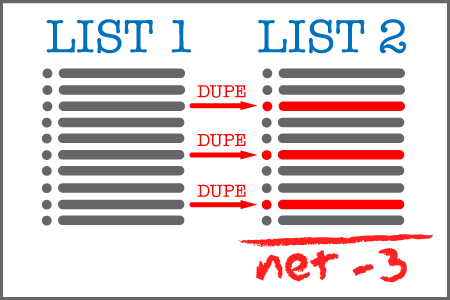Practically Perfect
Mailing lists can be expensive. For large mailings, direct marketers may acquire multiple mailing lists, or augment their customer databases with purchased lists in order to expand coverage. When attempting to cast a wide net, duplication inevitably occurs. Net name arrangements are a way for mailing list owners and managers to provide some degree of “uniqueness insurance” to minimize waste by duplication.
The way it works is fairly straightforward. There is a cost per thousand names for a list ($/M). If a net name clause is included in the rental agreement, it may require that a percentage of the total order must be paid for at the full price. It will go on to specify a discounted rate for any portion of the list between that and the original total found to be duplicates. Any thorough merge/purge process should readily reveal these duplicate records. By so doing, list owners and mangers are offering accommodation to purchasers that saves money in printing and mailing. Such arrangements tend to require large orders and are not always available.
Acknowledging redundancy or dilution present in an item purchased in quantity (number, weight,etc.) – and associated remedies – is not unique to mailing lists.
The Gold Standard, Or, Dangling A Carat
Even that most precious commodity – gold – is governed by a measure of purity that is reflected in the buyer’s cost. We are all familiar with carat ratings of gold. 24 karat gold contains 24 parts pure gold, yielding a fineness of 1. 18 karat gold contains 18 parts pure gold with 6 parts of other metals added, resulting in a fineness of .75. In each case, the presence of alloy metals represents weight but not substance, hence a lower cost to a buyer of gold in any form. The “net name” metaphor applied here means that the buyer does not pay the full gold price for constituents of lesser value, as with duplicate records. Learn more about gold purity.
Plusses & Minuses
Surveys and polls are often mistaken for gospel. They are however permeated by statistical frailties that may be at odds with reality. Virtually all polls come with the disclaimer that amounts to “take with a grain of salt” in the form of a margin for error. Just how salty the results are may vary.
One of the bugaboos that bedevils polling is “Coverage Error”. Unlike net name arrangements these are errors of omission rather than duplication. Examples include people who are unavailable to respond or unwilling to do so. The proliferation of caller ID and general disaffection with telemarketing in general may affect phone surveys. This is reminiscent of net name arrangements in that the reported sample inadequately represents the universe being polled. The discrepancy is expressed as part of “Total Survey Error”. As with de-duping a mailing list via merge/purge, minimizing coverage error is dependent on a rigorous process.
Remedies offered by the polling industry include weighting of responses if indeed the actual respondents are found to be skewed from known attributes of the group being polled, such as age, gender, income, etc. An instructive tutorial overview of this issue is available online from Roper Center at Cornell University.
Net name arrangements are one way the data industry provides list purchasers with greater assurance of a list’s efficiency and cost savings. De-duplication is one of several critical hygiene techniques that, when used properly, can scour lists for outdated records, separate businesses from individuals, and more.




